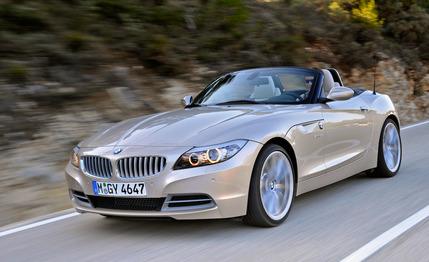
 First Drive Review
First Drive Review


As the brand’s only two-seater, the Z4 carries the torch for BMW’s sports-car line, which traces back to the Z8, 507 TS, and 328 (the one from the ’30s, not the modern sedan). The Z’s new folding-hardtop roadster/coupe configuration allows for more freedom in design, and it is one of the harbingers of the BMW look for the next few years. Thankfully, the questionable styling cues of the previous Z4 have been refined into a more sophisticated and elegant form. With the me-too product strategies employed by the German luxury brands, BMW needs a strong competitor in this segment to demonstrate its ability to build a high-performance car that can match the best that Audi, Mercedes-Benz, and Porsche have to offer.
We drove the 300-hp, 3.0-liter twin-turbocharged inline-six, which sees duty across the BMW lineup; thus equipped, this car carries the ridiculous sDrive35i badge. The sDrive part denotes rear-wheel drive, and the absurd naming convention—a similar xDrive badge is applied to all-wheel-drive versions of the 3-series and BMW’s SUVs—is reportedly used to better protect the brand’s trademarks. The base engine for North America is the naturally aspirated 255-hp, 3.0-liter inline-six also found in many other Bimmers, here badged sDrive30i. Since the previous Z4—as well as the Z3 that preceded that car—came in an M version, it would be natural to assume a new M roadster is on the way. There’s certainly plenty of room under the hood for the 4.0-liter V-8 from the M3, but the BMW M division says it’s not working on such a project. Both current models come standard with a six-speed manual transmission. The base car can also be optioned with a six-speed automatic. Turbo models without a clutch pedal are equipped with a seven-speed dual-clutch gearbox called “7-speed Sports Automatic with Double Clutch.”
Twin-Clutch Gearboxes Begin to Spread Throughout the Lineup
The automatic in the sDrive35i (yep, the name still sounds silly) is the first application of a double-clutch gearbox in a BMW outside of the M3. This one is nearly identical to the M3’s, which is called M DCT; all the gear ratios except for second are the same. The shift lever in the Z4 is similar to the one found in the X5, X6, and 7-series, and the steering-wheel-mounted shift buttons are a pull-for-upshift, push-for-downshift configuration instead of the right-up, left-down paddles in the M3. Another difference from the M3 is that the Z4 will shift to a higher gear if you brush the redline in manual mode. The Z4 also lacks the adjustable shift programs found on the M DCT, so instead of choosing between six different settings, you’ll have to make do with the baked-in programming. It’s actually refreshingly simple, considering BMW’s need to overload the driver with customizable settings in its M offerings.
Of course, it wouldn’t be a BMW without some settings to fiddle with. So the Z4 comes with Dynamic Drive Control and an optional adjustable M suspension, similar to that found on the new 7-series. A rocker switch to the right of the gearshift allows the driver to toggle among normal, sport, and sport plus modes. Moving in the sporty direction makes the throttle response more aggressive, the electric power steering heavier, and the gearshifts speedier. Sport plus goes a step further and puts the stability control in DTC (dynamic traction control) mode, which allows for more wheelspin and sideways action than when the stability system is fully activated. The adaptive M suspension starts with a 0.4-inch-lower ride and uses adjustable dampers to firm up the ride. BMW claims the base suspension is tuned more for comfort than the previous Z4’s; the adaptive suspension is similarly soft in normal mode but stiffer in both sport modes.